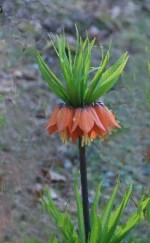 If you want an unusual flower for your garden in late spring, try crown imperial. At 3 feet tall it is no shrinking violet and with its whorl of downward facing flowers topped by a tuft of grass-like leaves it looks more like an exotic bird than a flower. Its bright colors ranging from scarlet to orange and yellow, are eye catching at a time when pastels dominate the garden. Dutch masters loved these flowers and included them in the lush bouquets they painted but I can’t help but wonder why they didn’t notice their skunk like odor. O.K., so you won’t use these in bouquets, but at least the smell drives away mice and other rodents. An awesome plant such as this does not come easily or cheaply so you may have to search around to find them. Unfortunately, these regal beauties, originally from native to Turkey and Iran, only last a few years in our gardens so hang on to the name of your source so you can replace them.
If you want an unusual flower for your garden in late spring, try crown imperial. At 3 feet tall it is no shrinking violet and with its whorl of downward facing flowers topped by a tuft of grass-like leaves it looks more like an exotic bird than a flower. Its bright colors ranging from scarlet to orange and yellow, are eye catching at a time when pastels dominate the garden. Dutch masters loved these flowers and included them in the lush bouquets they painted but I can’t help but wonder why they didn’t notice their skunk like odor. O.K., so you won’t use these in bouquets, but at least the smell drives away mice and other rodents. An awesome plant such as this does not come easily or cheaply so you may have to search around to find them. Unfortunately, these regal beauties, originally from native to Turkey and Iran, only last a few years in our gardens so hang on to the name of your source so you can replace them.

Type: Bulb.
Bloom: A whorl of bright red, yellow, or orange – 3” long downward facing flowers are produced in late spring.
Foliage: Alternate, lanceolate, dark green leaves 4-6” long are borne on 3’ stems with a tuft of leaves above the flowers that look like a crown.
Size: 3’ H x 1’ W.
Light: Full sun.
Soil: Fertile, moist well drained loam.
Hardiness: Zones 5-8.
Care: Plant bulbs immediately in fall 4-5” deep; place on their side so that water does not collect in the depression at the top of the bulb; cut stems to the ground after flowering; mulch in winter in zones 7 and colder.
Pests and Diseases: Susceptible to rust, leaf spot.
Propagation: Division in fall; seed possible but seeds take 4 years to develop to flowering state.
Companions: Plant in drifts in front of spring flowering shrubs.
Outstanding Selections:
 ‘Aurora’ (scarlet)
‘Aurora’ (scarlet) Var. lutea (lemon yellow)
Var. lutea (lemon yellow) ‘Orange Brilliant’ (clear orange)
‘Orange Brilliant’ (clear orange) Var. rubra (red)
Var. rubra (red)